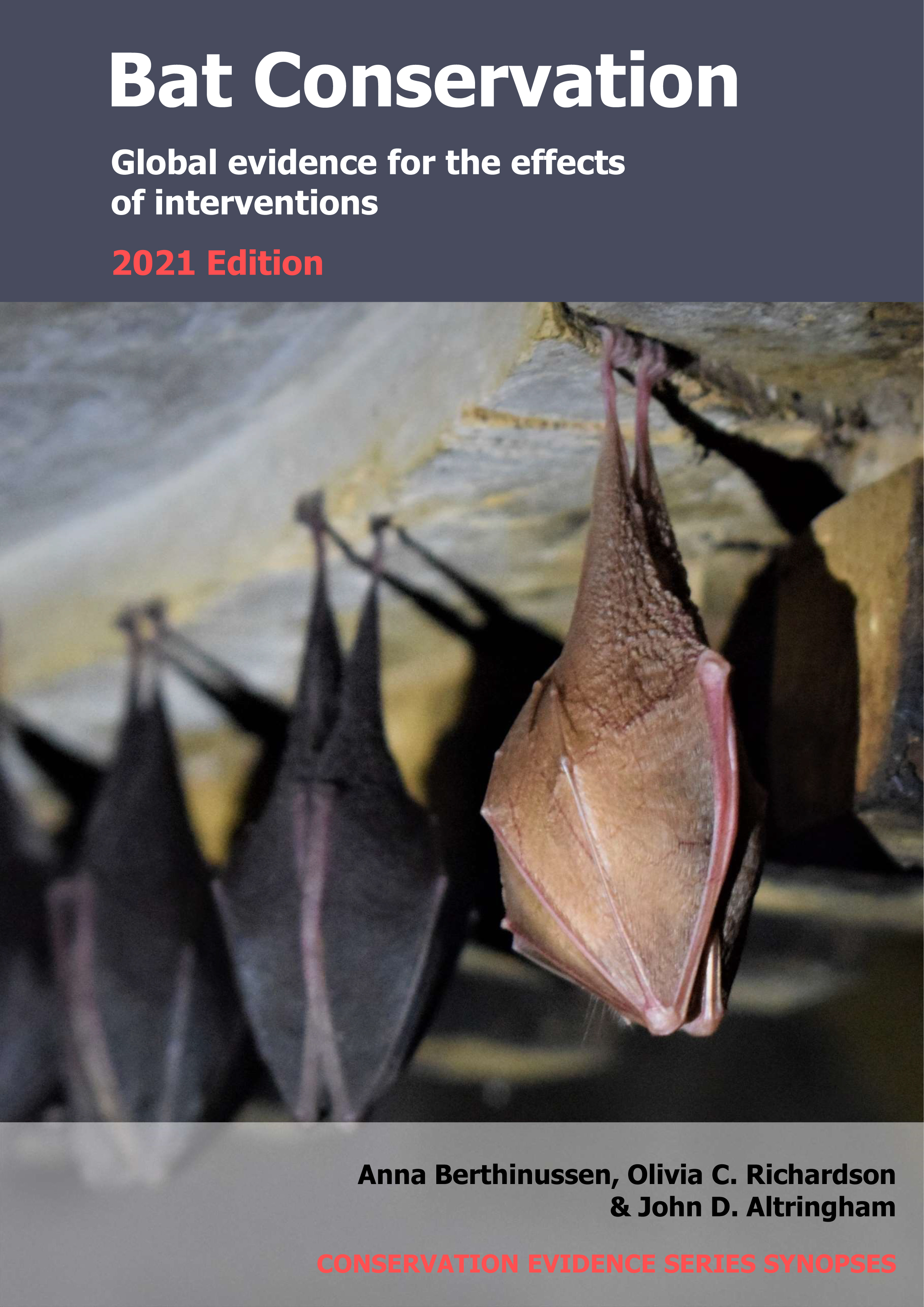Legally protect bats during development
-
Overall effectiveness category Unknown effectiveness (limited evidence)
-
Number of studies: 4
View assessment score
Hide assessment score
How is the evidence assessed?
-
Effectiveness
45% -
Certainty
35% -
Harms
10%
Study locations
Supporting evidence from individual studies
A review of 389 bat mitigation licences issued in 2003–2005 in England, UK (Stone et al 2013) found that overall the effect of licenced activities on bat roosts was negative and the majority of roosts for which licenses were issued were destroyed during development. Overall, bat roosts were more likely to be destroyed (68%) than damaged (20%) or disturbed (12%). Most licensees (67%) failed to submit post-development reports, and post-development monitoring was conducted at only 19% of sites. The licences analysed related to 1,776 roosts of 15 bat species and were issued for three types of development (renovation, conversion, and demolition). A total of 2,536 structures for bats, of 10 types, were installed under the licences including bat boxes (1,690), bat lofts (362), bat barns (12), bat houses (10), bat towers (2), cellars/caves (18), building enhancements for bats, e.g. crevices and cavities in roofs and walls (437), a covered shed (2), a light sampling canopy (1) and a grille (1).
Study and other actions testedA replicated, before-and-after study in 2011–2015 of 28 bat maternity roosts subject to licenced building developments across Scotland, UK (Mackintosh 2016) found that five of 28 compensation roosts provided were used as maternity roosts by the target bat species after development, and two of the five roosts were used by a similar or greater number of bats as before the development. Average roost counts before and after development at the four roosts either remained stable (before: 2 brown long-eared bats Plecotus auritus; after: 2 brown long-eared bats), increased by 7% (before: 476 soprano pipistrelles Pipistrellus pygmaeus; after 507 soprano pipistrelles), decreased by 39% (before: 341 soprano pipistrelles; after: 208 soprano pipistrelles), or could not be counted (use inferred from brown long-eared bat droppings only). Four of five sites retained the original bat roost and access points within the development, and one site had bat boxes installed (3 x Schwegler design 1FFH) on an external wall near the original roost location. Compensation roosts followed the designs in Species Protection Plans. The numbers of bats counted before development at each roost were extracted from reports submitted with licence applications. Bats were counted at each roost after development during at least one dusk emergence or dawn re-entry survey between May and September 2015.
Study and other actions testedA review in 2015 of development licences affecting bats across Scotland, UK (Mackintosh 2016) found that the number of licences issued had increased from 2012 to 2014. Licences issued increased over three years from 80 in 2012 to 180 in 2014. A total of 437 development licences were issued for bats between July 2011 and December 2014, 67 of which related to maternity roost sites. All UK bat species are protected by UK and European law. Licences are therefore issued for certain activities that involve mitigation and/or compensation for the impacts of development. Licensing information collected by the governmental licensing authority, Scottish Natural Heritage, was analysed.
Study and other actions testedA review in 2018 of 283 studies of bat roosts subject to licenced building developments in the UK (Lintott & Mathews 2018) found that 31–67% of compensation roosts were used by bats after development. Bats used 67% of roosts retained and modified during reroofing work, 52% of newly created bat lofts, and 31% of bat boxes after development (the number of bats using roosts and bat lofts/bat boxes before and after development were not reported). The roosts were used by common pipistrelles Pipistrellus pipistrellus, soprano pipistrelles Pipistrellus pygmaeus, brown long-eared bats Plecotus auritus and Myotis spp. (see original report for data for individual species). The 283 studies (52 for retained and modified roosts, 112 for bat lofts, 119 for bat boxes; dates not reported) were collected from multiple sources, including practitioner reports and licence applications from across the UK, and reviewed in 2018.
Study and other actions tested
Where has this evidence come from?
List of journals searched by synopsis
All the journals searched for all synopses
This Action forms part of the Action Synopsis:
Bat Conservation
Bat Conservation - Published 2021
Update 2020





)_2023.JPG)














